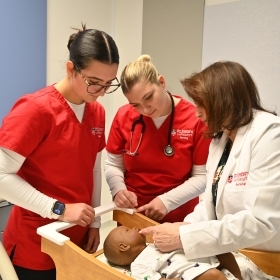Neuroscience Master’s Curriculum: What to Expect

Neuroscience is the science behind human thought, emotions and behaviors and involves studying the physical aspects of the brain and central nervous system. Obtaining a master’s in neuroscience can prepare you to eventually go on to earn your Ph.D., but a master’s in neuroscience can also prepare you for careers in research – such as university programs, pharmaceutical companies, or the government – just to name a few. What does it look like to get your master’s in neuroscience? What are the types of courses you’ll take along the way? Let’s explore the curriculum for earning a master’s in neuroscience.
Where to Start
Thesis or Non-Thesis Pathway
Many neuroscience programs offer a non-thesis option as well as the traditional thesis option for their neuroscience master’s programs. Which route you should take will depend on your current career trajectory and your plans for post-graduation. If you’ve already been working in the field and do not plan to pursue your Ph.D., the non-thesis option would be a good choice. However, if you plan to continue on in academia and pursue your doctorate , the thesis track is highly recommended.
Neuroscience Master’s Core Courses
St. John’s University’s M.S. in Neuroscience has three core courses that every student must take regardless of their track or career plans: Molecular Biology, Molecular Neuroscience, and Cell Biology. These foundational courses are critical for grounding any future research or careers in neuroscience. Additionally, each student must also choose between one of the following neuroanatomy courses: Neurobiology of Speech and Language or Functional Neuroanatomy and Neuropathology.
Neuroscience Electives
Once a student has completed their core coursework, they can select electives to flesh out their educational pathway. Depending on your career objectives, the courses you select may vary. To decide which electives are best for you, you can consult with advisors so you can select courses that align with your career and research goals. Here is a list of the electives available from St. John’s University:
- Bioinformatics
- Graduate Research Presentations
- Biostatics
- Cognitive and Affective Bases of Behavior
- Lab Techniques
- Departmental Seminar
- Cell and Tissue Culture
- Physiological Psychology
- Communication Skills in the Life Sciences
- Special Topics in Biology
- Cell and Tissue Culture Laboratory
- Neuropsychological Assessment
- Scientific Literacy & Integrity
- Special Topics in Communication Sciences and Disorders
- Foundations of Data Analysis
- Neurotoxicology
Neuroscience Master’s Program Admissions
Typically, a student can complete the M.S. in Neuroscience in two years if they are taking coursework full-time. And while there are no official prerequisites for admission, having a related undergraduate degree will be beneficial in pursuing the master’s. However, even if you don’t have a related degree, St. John’s University will recommend completing a series of undergraduate courses such as organic chemistry (or others depending on your particular background) to prepare you for admission.
Pursue a Master of Science (M.S.) Degree in Neuroscience from St. John’s
St. John’s offers small classes as well as unique research opportunities when obtaining your master’s in Neuroscience. Because of the interdisciplinary nature of neuroscience, the faculty at St. John's reflects that with experts across multiple disciplines. We have faculty that span both the arts and sciences so you will learn from experts in your selected courses and your studies will help you with your research endeavors. No matter which path you choose, St. John’s University has courses suited to your interests. Learn more about the St. John’s University Masters in Neuroscience program today.







